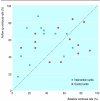Randomised trial of educational visits to enhance use of systematic reviews in 25 obstetric units
- PMID: 9774287
- PMCID: PMC28686
- DOI: 10.1136/bmj.317.7165.1041
Randomised trial of educational visits to enhance use of systematic reviews in 25 obstetric units
Abstract
Objective: To evaluate the effectiveness of an educational visit to help obstetricians and midwives select and use evidence from a Cochrane database containing 600 systematic reviews.
Design: Randomised single blind controlled trial with obstetric units allocated to an educational visit or control group.
Setting: 25 of the 26 district general obstetric units in two former NHS regions.
Subjects: The senior obstetrician and midwife from each intervention unit participated in educational visits. Clinical practices of all staff were assessed in 4508 pregnancies.
Intervention: Single informal educational visit by a respected obstetrician including discussion of evidence based obstetrics, guidance on implementation, and donation of Cochrane database and other materials.
Main outcome measures: Rates of perineal suturing with polyglycolic acid, ventouse delivery, prophylactic antibiotics in caesarean section, and steroids in preterm delivery, before and 9 months after visits, and concordance of guidelines with review evidence for same marker practices before and after visits.
Results: Rates varied greatly, but the overall baseline mean of 43% (986/2312) increased to 54% (1189/2196) 9 months later. Rates of ventouse delivery increased significantly in intervention units but not in control units; there was no difference between the two types of units in uptake of other practices. Pooling rates from all 25 units, use of antibiotics in caesarean section and use of polyglycolic acid sutures increased significantly over the period, but use of steroids in preterm delivery was unchanged. Labour ward guidelines seldom agreed with evidence at baseline; this hardly improved after visits. Educational visits cost pound860 each (at 1995 prices).
Conclusions: There was considerable uptake of evidence into practice in both control and intervention units between 1994 and 1995. Our educational visits added little to this, despite the informal setting, targeting of senior staff from two disciplines, and donation of educational materials. Further work is needed to define cost effective methods to enhance the uptake of evidence from systematic reviews and to clarify leadership and roles of senior obstetric staff in implementing the evidence.
Figures
Comment in
-
Changing practice in maternity care: it's hard to know what works.BMJ. 1998 Oct 17;317(7165):1027-8. doi: 10.1136/bmj.317.7165.1027. BMJ. 1998. PMID: 9774283 Free PMC article. No abstract available.
-
Value of educational visits in obstetrics. Randomised controlled trial was unsuitable evaluation.BMJ. 1999 Apr 24;318(7191):1143-4. doi: 10.1136/bmj.318.7191.1143c. BMJ. 1999. PMID: 10213750 Free PMC article. No abstract available.
-
Values of educational visits in obstetrics. Good clinical audit is needed for interpreting systematic reviews.BMJ. 1999 Apr 24;318(7191):1144. BMJ. 1999. PMID: 10366270 No abstract available.
-
Values of educational visits in obstetrics. Staff changes will have affected ventouse rates.BMJ. 1999 Apr 24;318(7191):1144. BMJ. 1999. PMID: 10366271 No abstract available.
References
-
- Peto R, Collins R, Gray R. Large-scale randomised evidence: large, simple trials and overviews of trials. Annals NY Acad Sci. 1993;703:314–340. - PubMed
-
- Antman E, Lau J, Kupelnick B, Mosteller F, Chalmers T. A comparison of the results of meta-analysis of randomised controlled trials and recommendations of clinical experts. JAMA. 1992;268:240–248. - PubMed
-
- Stross J. Relationship between knowledge and experience in use of anti-rheumatics. JAMA. 1989;262:2721–2723. - PubMed
Publication types
MeSH terms
LinkOut - more resources
Full Text Sources



